Report: Principles of Infection Control in Dental Environment
VerifiedAdded on 2021/01/02
|9
|1776
|452
Report
AI Summary
This report comprehensively examines the principles of infection control within a dental environment. It begins by outlining relevant safety and health legislation, including the Health and Safety at Work Act, COSHH, RIDDOR, and the Public Health Act. The report then details methods for preventing cross-infection, emphasizing hand hygiene, protective clothing, safe handling, and waste management. It discusses the causes and routes of cross-infection, defining key standard terms like pathogen, non-pathogen, virus, bacteria, spores, and fungi. Furthermore, the report addresses the necessity of immunization for dental personnel, listing five essential diseases and the relevant immunization timelines. It also explores conditions impacting the dental setting, transmission precautions, and specific infectious diseases like Hepatitis B and HIV. The report concludes by analyzing various chemical decontaminants, different methods of dental sterilization, and reflecting on the importance of decontaminating the clinical environment after use, referencing key literature such as Miller and Palenik's 'Infection Control and Management of Hazardous Materials for the Dental Team' and Lang and Lindhe's 'Clinical Periodontology and Implant Dentistry'. The report emphasizes the importance of maintaining a safe environment for both patients and healthcare workers.
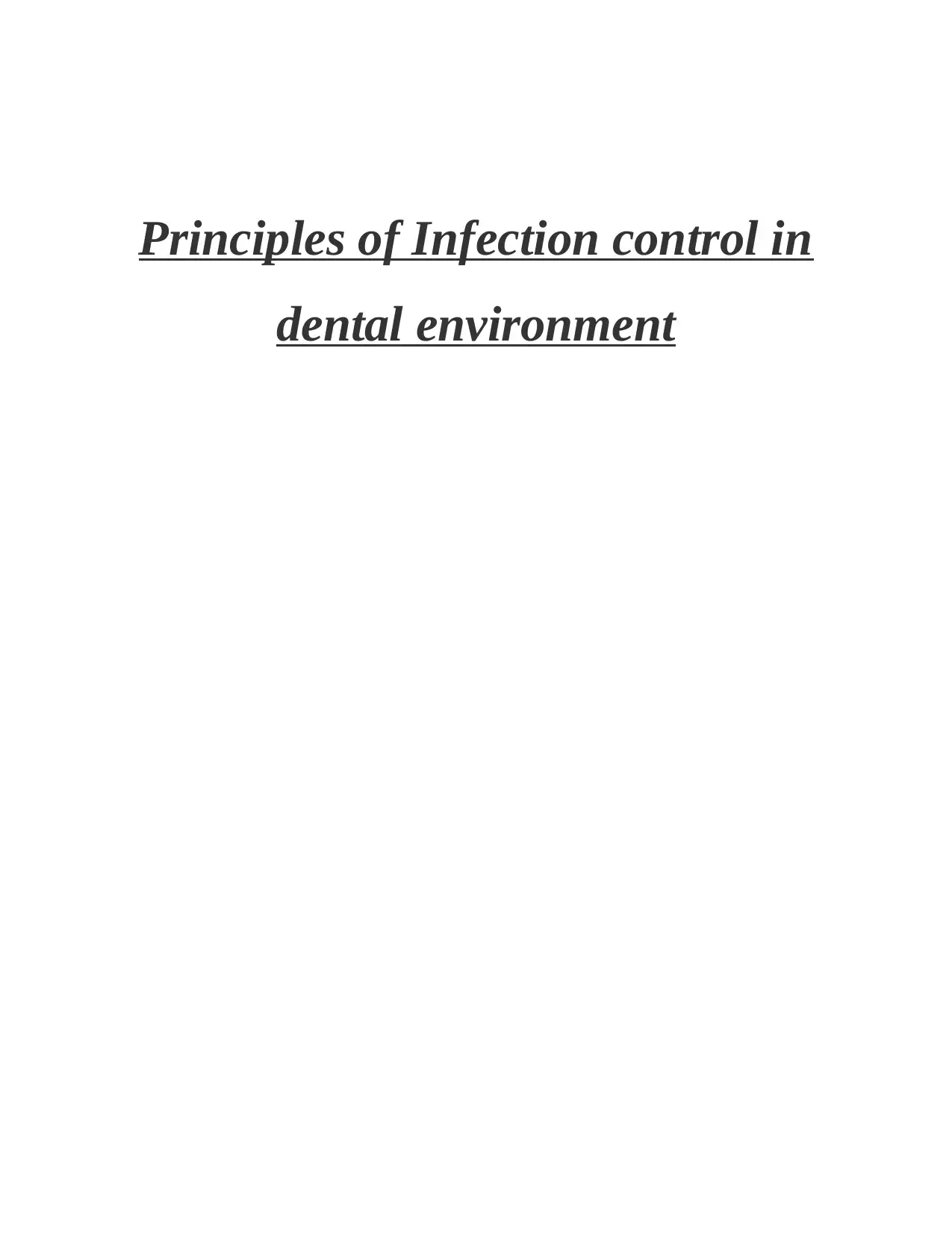
Principles of Infection control in
dental environment
dental environment
Paraphrase This Document
Need a fresh take? Get an instant paraphrase of this document with our AI Paraphraser
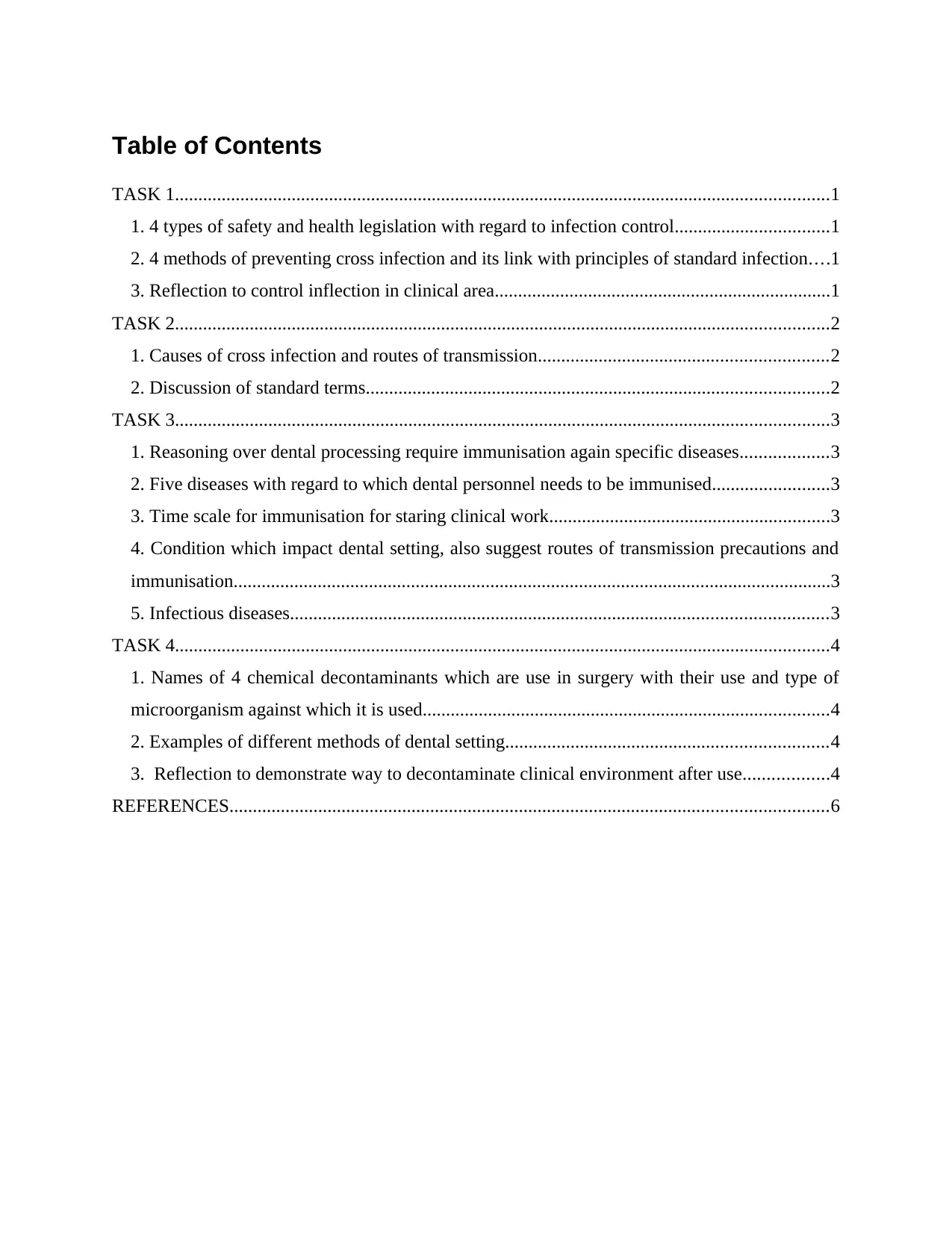
Table of Contents
TASK 1............................................................................................................................................1
1. 4 types of safety and health legislation with regard to infection control.................................1
2. 4 methods of preventing cross infection and its link with principles of standard infection....1
3. Reflection to control inflection in clinical area........................................................................1
TASK 2............................................................................................................................................2
1. Causes of cross infection and routes of transmission..............................................................2
2. Discussion of standard terms...................................................................................................2
TASK 3............................................................................................................................................3
1. Reasoning over dental processing require immunisation again specific diseases...................3
2. Five diseases with regard to which dental personnel needs to be immunised.........................3
3. Time scale for immunisation for staring clinical work............................................................3
4. Condition which impact dental setting, also suggest routes of transmission precautions and
immunisation................................................................................................................................3
5. Infectious diseases...................................................................................................................3
TASK 4............................................................................................................................................4
1. Names of 4 chemical decontaminants which are use in surgery with their use and type of
microorganism against which it is used.......................................................................................4
2. Examples of different methods of dental setting.....................................................................4
3. Reflection to demonstrate way to decontaminate clinical environment after use..................4
REFERENCES................................................................................................................................6
TASK 1............................................................................................................................................1
1. 4 types of safety and health legislation with regard to infection control.................................1
2. 4 methods of preventing cross infection and its link with principles of standard infection....1
3. Reflection to control inflection in clinical area........................................................................1
TASK 2............................................................................................................................................2
1. Causes of cross infection and routes of transmission..............................................................2
2. Discussion of standard terms...................................................................................................2
TASK 3............................................................................................................................................3
1. Reasoning over dental processing require immunisation again specific diseases...................3
2. Five diseases with regard to which dental personnel needs to be immunised.........................3
3. Time scale for immunisation for staring clinical work............................................................3
4. Condition which impact dental setting, also suggest routes of transmission precautions and
immunisation................................................................................................................................3
5. Infectious diseases...................................................................................................................3
TASK 4............................................................................................................................................4
1. Names of 4 chemical decontaminants which are use in surgery with their use and type of
microorganism against which it is used.......................................................................................4
2. Examples of different methods of dental setting.....................................................................4
3. Reflection to demonstrate way to decontaminate clinical environment after use..................4
REFERENCES................................................................................................................................6
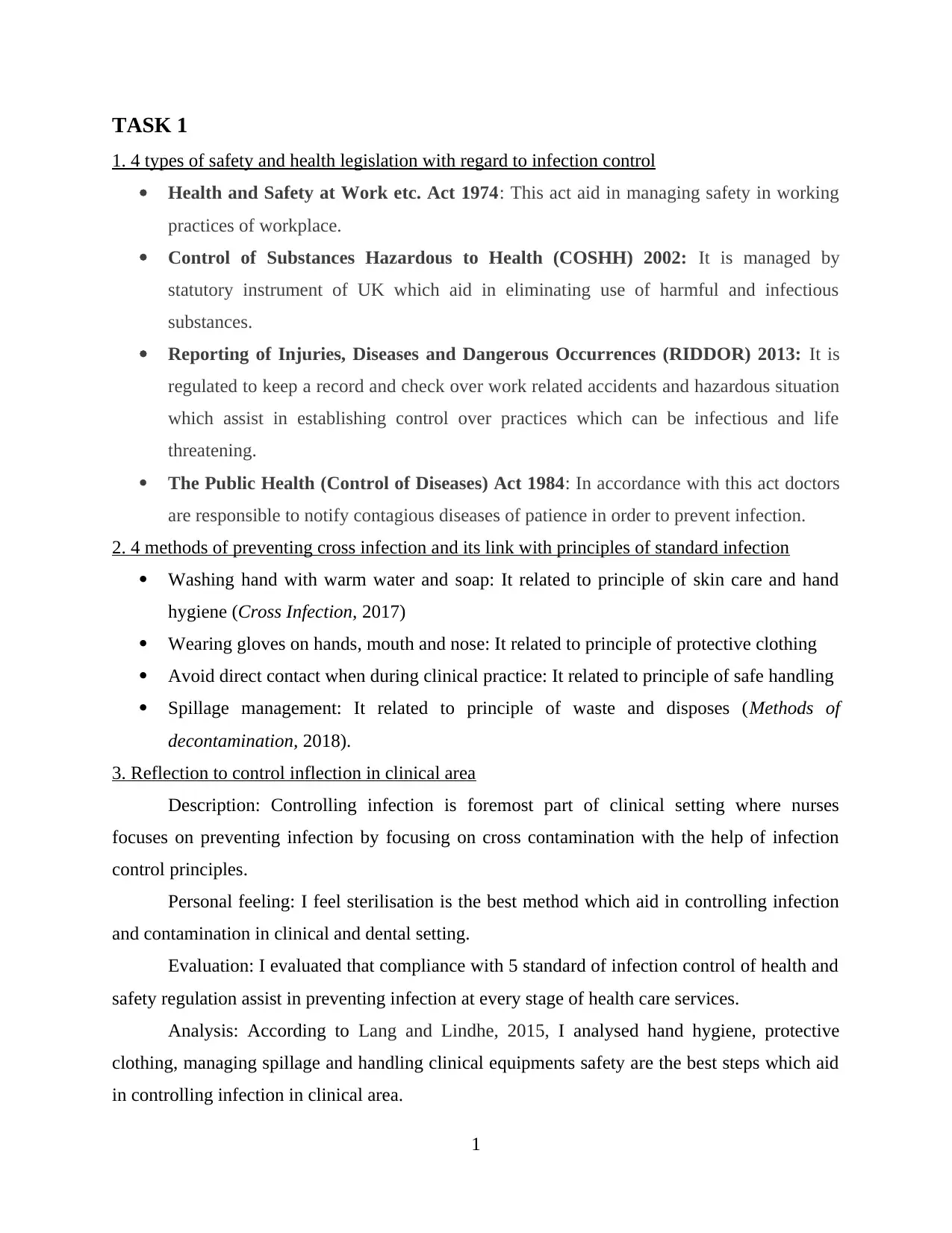
TASK 1
1. 4 types of safety and health legislation with regard to infection control
Health and Safety at Work etc. Act 1974: This act aid in managing safety in working
practices of workplace.
Control of Substances Hazardous to Health (COSHH) 2002: It is managed by
statutory instrument of UK which aid in eliminating use of harmful and infectious
substances.
Reporting of Injuries, Diseases and Dangerous Occurrences (RIDDOR) 2013: It is
regulated to keep a record and check over work related accidents and hazardous situation
which assist in establishing control over practices which can be infectious and life
threatening.
The Public Health (Control of Diseases) Act 1984: In accordance with this act doctors
are responsible to notify contagious diseases of patience in order to prevent infection.
2. 4 methods of preventing cross infection and its link with principles of standard infection
Washing hand with warm water and soap: It related to principle of skin care and hand
hygiene (Cross Infection, 2017)
Wearing gloves on hands, mouth and nose: It related to principle of protective clothing
Avoid direct contact when during clinical practice: It related to principle of safe handling
Spillage management: It related to principle of waste and disposes (Methods of
decontamination, 2018).
3. Reflection to control inflection in clinical area
Description: Controlling infection is foremost part of clinical setting where nurses
focuses on preventing infection by focusing on cross contamination with the help of infection
control principles.
Personal feeling: I feel sterilisation is the best method which aid in controlling infection
and contamination in clinical and dental setting.
Evaluation: I evaluated that compliance with 5 standard of infection control of health and
safety regulation assist in preventing infection at every stage of health care services.
Analysis: According to Lang and Lindhe, 2015, I analysed hand hygiene, protective
clothing, managing spillage and handling clinical equipments safety are the best steps which aid
in controlling infection in clinical area.
1
1. 4 types of safety and health legislation with regard to infection control
Health and Safety at Work etc. Act 1974: This act aid in managing safety in working
practices of workplace.
Control of Substances Hazardous to Health (COSHH) 2002: It is managed by
statutory instrument of UK which aid in eliminating use of harmful and infectious
substances.
Reporting of Injuries, Diseases and Dangerous Occurrences (RIDDOR) 2013: It is
regulated to keep a record and check over work related accidents and hazardous situation
which assist in establishing control over practices which can be infectious and life
threatening.
The Public Health (Control of Diseases) Act 1984: In accordance with this act doctors
are responsible to notify contagious diseases of patience in order to prevent infection.
2. 4 methods of preventing cross infection and its link with principles of standard infection
Washing hand with warm water and soap: It related to principle of skin care and hand
hygiene (Cross Infection, 2017)
Wearing gloves on hands, mouth and nose: It related to principle of protective clothing
Avoid direct contact when during clinical practice: It related to principle of safe handling
Spillage management: It related to principle of waste and disposes (Methods of
decontamination, 2018).
3. Reflection to control inflection in clinical area
Description: Controlling infection is foremost part of clinical setting where nurses
focuses on preventing infection by focusing on cross contamination with the help of infection
control principles.
Personal feeling: I feel sterilisation is the best method which aid in controlling infection
and contamination in clinical and dental setting.
Evaluation: I evaluated that compliance with 5 standard of infection control of health and
safety regulation assist in preventing infection at every stage of health care services.
Analysis: According to Lang and Lindhe, 2015, I analysed hand hygiene, protective
clothing, managing spillage and handling clinical equipments safety are the best steps which aid
in controlling infection in clinical area.
1
⊘ This is a preview!⊘
Do you want full access?
Subscribe today to unlock all pages.

Trusted by 1+ million students worldwide
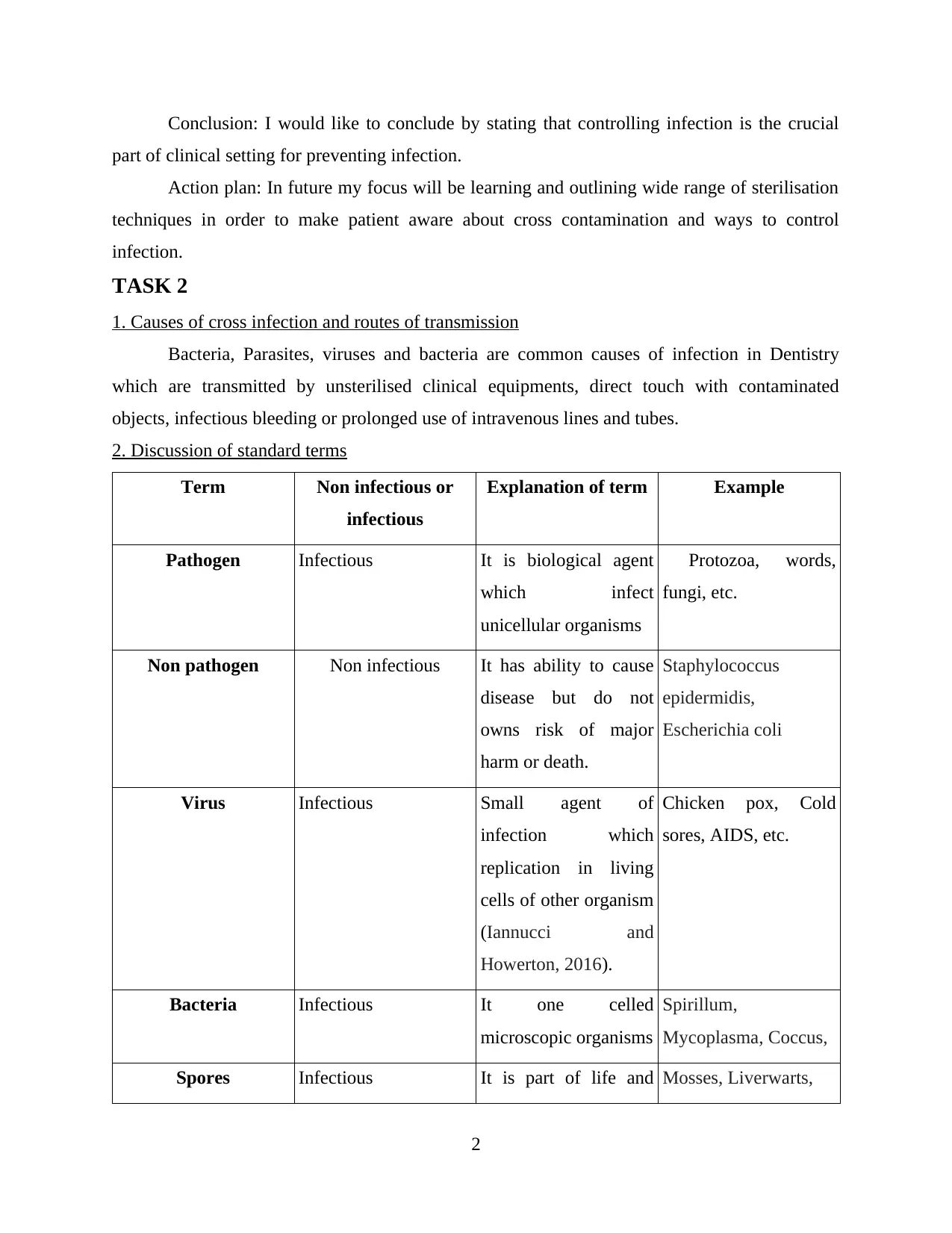
Conclusion: I would like to conclude by stating that controlling infection is the crucial
part of clinical setting for preventing infection.
Action plan: In future my focus will be learning and outlining wide range of sterilisation
techniques in order to make patient aware about cross contamination and ways to control
infection.
TASK 2
1. Causes of cross infection and routes of transmission
Bacteria, Parasites, viruses and bacteria are common causes of infection in Dentistry
which are transmitted by unsterilised clinical equipments, direct touch with contaminated
objects, infectious bleeding or prolonged use of intravenous lines and tubes.
2. Discussion of standard terms
Term Non infectious or
infectious
Explanation of term Example
Pathogen Infectious It is biological agent
which infect
unicellular organisms
Protozoa, words,
fungi, etc.
Non pathogen Non infectious It has ability to cause
disease but do not
owns risk of major
harm or death.
Staphylococcus
epidermidis,
Escherichia coli
Virus Infectious Small agent of
infection which
replication in living
cells of other organism
(Iannucci and
Howerton, 2016).
Chicken pox, Cold
sores, AIDS, etc.
Bacteria Infectious It one celled
microscopic organisms
Spirillum,
Mycoplasma, Coccus,
Spores Infectious It is part of life and Mosses, Liverwarts,
2
part of clinical setting for preventing infection.
Action plan: In future my focus will be learning and outlining wide range of sterilisation
techniques in order to make patient aware about cross contamination and ways to control
infection.
TASK 2
1. Causes of cross infection and routes of transmission
Bacteria, Parasites, viruses and bacteria are common causes of infection in Dentistry
which are transmitted by unsterilised clinical equipments, direct touch with contaminated
objects, infectious bleeding or prolonged use of intravenous lines and tubes.
2. Discussion of standard terms
Term Non infectious or
infectious
Explanation of term Example
Pathogen Infectious It is biological agent
which infect
unicellular organisms
Protozoa, words,
fungi, etc.
Non pathogen Non infectious It has ability to cause
disease but do not
owns risk of major
harm or death.
Staphylococcus
epidermidis,
Escherichia coli
Virus Infectious Small agent of
infection which
replication in living
cells of other organism
(Iannucci and
Howerton, 2016).
Chicken pox, Cold
sores, AIDS, etc.
Bacteria Infectious It one celled
microscopic organisms
Spirillum,
Mycoplasma, Coccus,
Spores Infectious It is part of life and Mosses, Liverwarts,
2
Paraphrase This Document
Need a fresh take? Get an instant paraphrase of this document with our AI Paraphraser
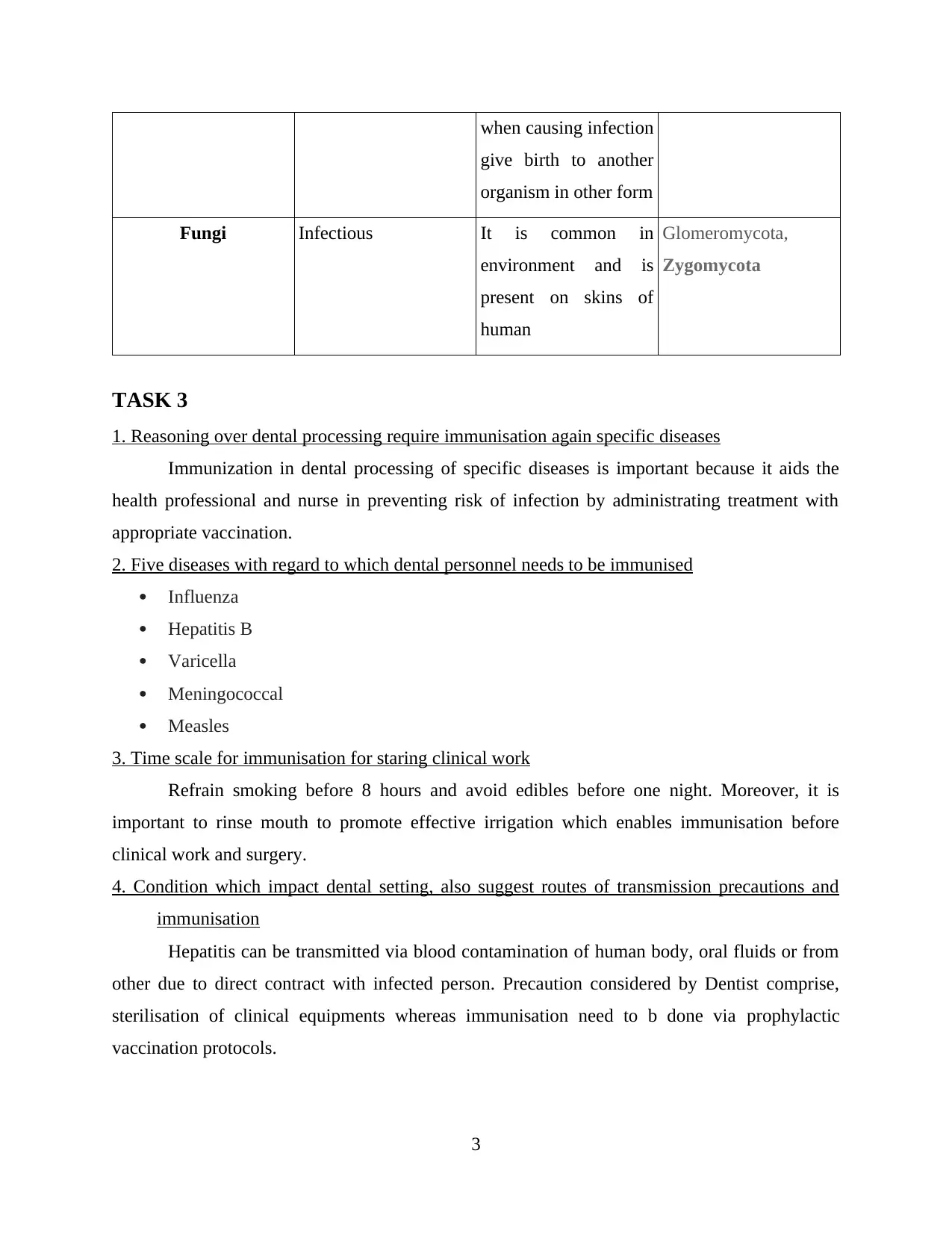
when causing infection
give birth to another
organism in other form
Fungi Infectious It is common in
environment and is
present on skins of
human
Glomeromycota,
Zygomycota
TASK 3
1. Reasoning over dental processing require immunisation again specific diseases
Immunization in dental processing of specific diseases is important because it aids the
health professional and nurse in preventing risk of infection by administrating treatment with
appropriate vaccination.
2. Five diseases with regard to which dental personnel needs to be immunised
Influenza
Hepatitis B
Varicella
Meningococcal
Measles
3. Time scale for immunisation for staring clinical work
Refrain smoking before 8 hours and avoid edibles before one night. Moreover, it is
important to rinse mouth to promote effective irrigation which enables immunisation before
clinical work and surgery.
4. Condition which impact dental setting, also suggest routes of transmission precautions and
immunisation
Hepatitis can be transmitted via blood contamination of human body, oral fluids or from
other due to direct contract with infected person. Precaution considered by Dentist comprise,
sterilisation of clinical equipments whereas immunisation need to b done via prophylactic
vaccination protocols.
3
give birth to another
organism in other form
Fungi Infectious It is common in
environment and is
present on skins of
human
Glomeromycota,
Zygomycota
TASK 3
1. Reasoning over dental processing require immunisation again specific diseases
Immunization in dental processing of specific diseases is important because it aids the
health professional and nurse in preventing risk of infection by administrating treatment with
appropriate vaccination.
2. Five diseases with regard to which dental personnel needs to be immunised
Influenza
Hepatitis B
Varicella
Meningococcal
Measles
3. Time scale for immunisation for staring clinical work
Refrain smoking before 8 hours and avoid edibles before one night. Moreover, it is
important to rinse mouth to promote effective irrigation which enables immunisation before
clinical work and surgery.
4. Condition which impact dental setting, also suggest routes of transmission precautions and
immunisation
Hepatitis can be transmitted via blood contamination of human body, oral fluids or from
other due to direct contract with infected person. Precaution considered by Dentist comprise,
sterilisation of clinical equipments whereas immunisation need to b done via prophylactic
vaccination protocols.
3
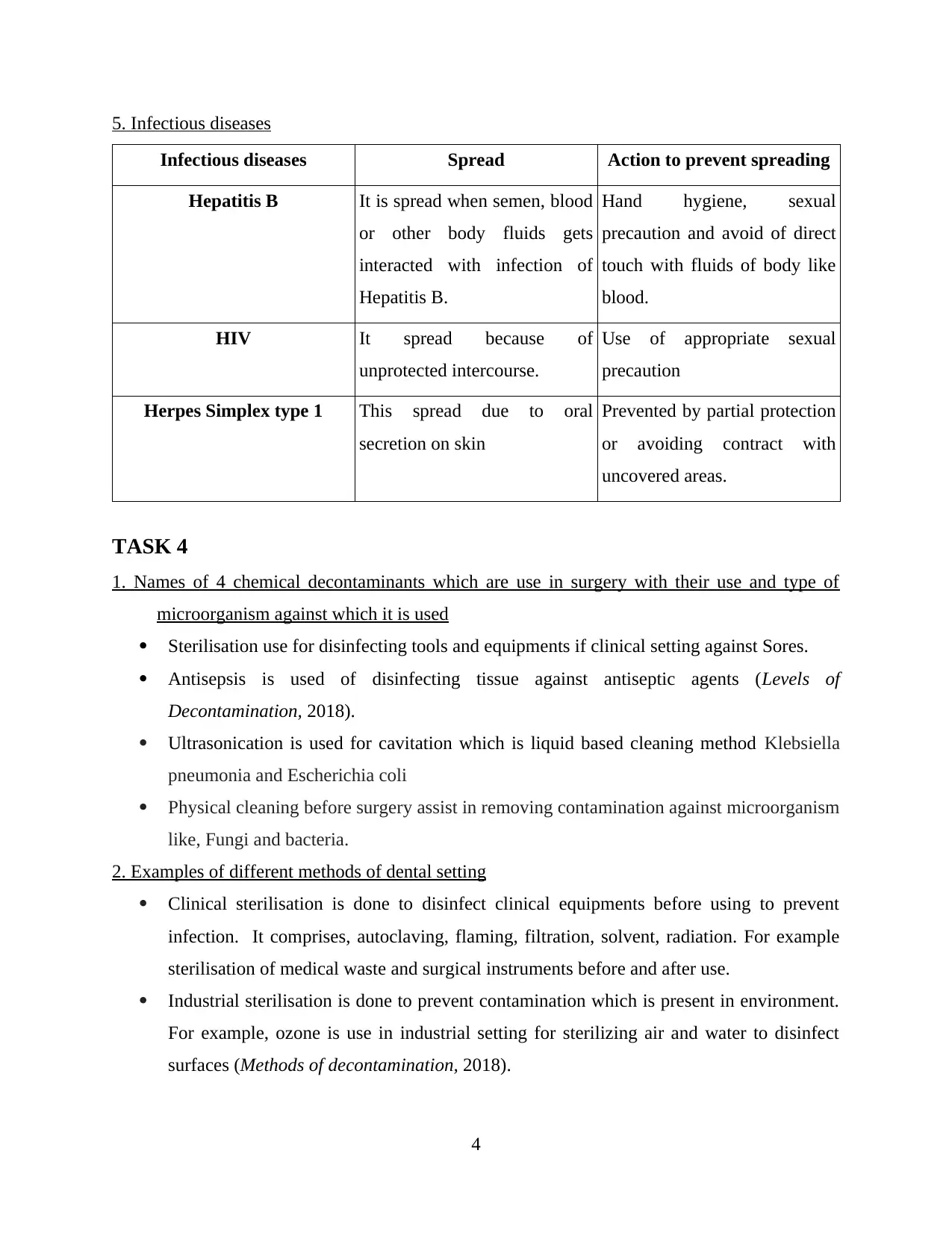
5. Infectious diseases
Infectious diseases Spread Action to prevent spreading
Hepatitis B It is spread when semen, blood
or other body fluids gets
interacted with infection of
Hepatitis B.
Hand hygiene, sexual
precaution and avoid of direct
touch with fluids of body like
blood.
HIV It spread because of
unprotected intercourse.
Use of appropriate sexual
precaution
Herpes Simplex type 1 This spread due to oral
secretion on skin
Prevented by partial protection
or avoiding contract with
uncovered areas.
TASK 4
1. Names of 4 chemical decontaminants which are use in surgery with their use and type of
microorganism against which it is used
Sterilisation use for disinfecting tools and equipments if clinical setting against Sores.
Antisepsis is used of disinfecting tissue against antiseptic agents (Levels of
Decontamination, 2018).
Ultrasonication is used for cavitation which is liquid based cleaning method Klebsiella
pneumonia and Escherichia coli
Physical cleaning before surgery assist in removing contamination against microorganism
like, Fungi and bacteria.
2. Examples of different methods of dental setting
Clinical sterilisation is done to disinfect clinical equipments before using to prevent
infection. It comprises, autoclaving, flaming, filtration, solvent, radiation. For example
sterilisation of medical waste and surgical instruments before and after use.
Industrial sterilisation is done to prevent contamination which is present in environment.
For example, ozone is use in industrial setting for sterilizing air and water to disinfect
surfaces (Methods of decontamination, 2018).
4
Infectious diseases Spread Action to prevent spreading
Hepatitis B It is spread when semen, blood
or other body fluids gets
interacted with infection of
Hepatitis B.
Hand hygiene, sexual
precaution and avoid of direct
touch with fluids of body like
blood.
HIV It spread because of
unprotected intercourse.
Use of appropriate sexual
precaution
Herpes Simplex type 1 This spread due to oral
secretion on skin
Prevented by partial protection
or avoiding contract with
uncovered areas.
TASK 4
1. Names of 4 chemical decontaminants which are use in surgery with their use and type of
microorganism against which it is used
Sterilisation use for disinfecting tools and equipments if clinical setting against Sores.
Antisepsis is used of disinfecting tissue against antiseptic agents (Levels of
Decontamination, 2018).
Ultrasonication is used for cavitation which is liquid based cleaning method Klebsiella
pneumonia and Escherichia coli
Physical cleaning before surgery assist in removing contamination against microorganism
like, Fungi and bacteria.
2. Examples of different methods of dental setting
Clinical sterilisation is done to disinfect clinical equipments before using to prevent
infection. It comprises, autoclaving, flaming, filtration, solvent, radiation. For example
sterilisation of medical waste and surgical instruments before and after use.
Industrial sterilisation is done to prevent contamination which is present in environment.
For example, ozone is use in industrial setting for sterilizing air and water to disinfect
surfaces (Methods of decontamination, 2018).
4
⊘ This is a preview!⊘
Do you want full access?
Subscribe today to unlock all pages.

Trusted by 1+ million students worldwide
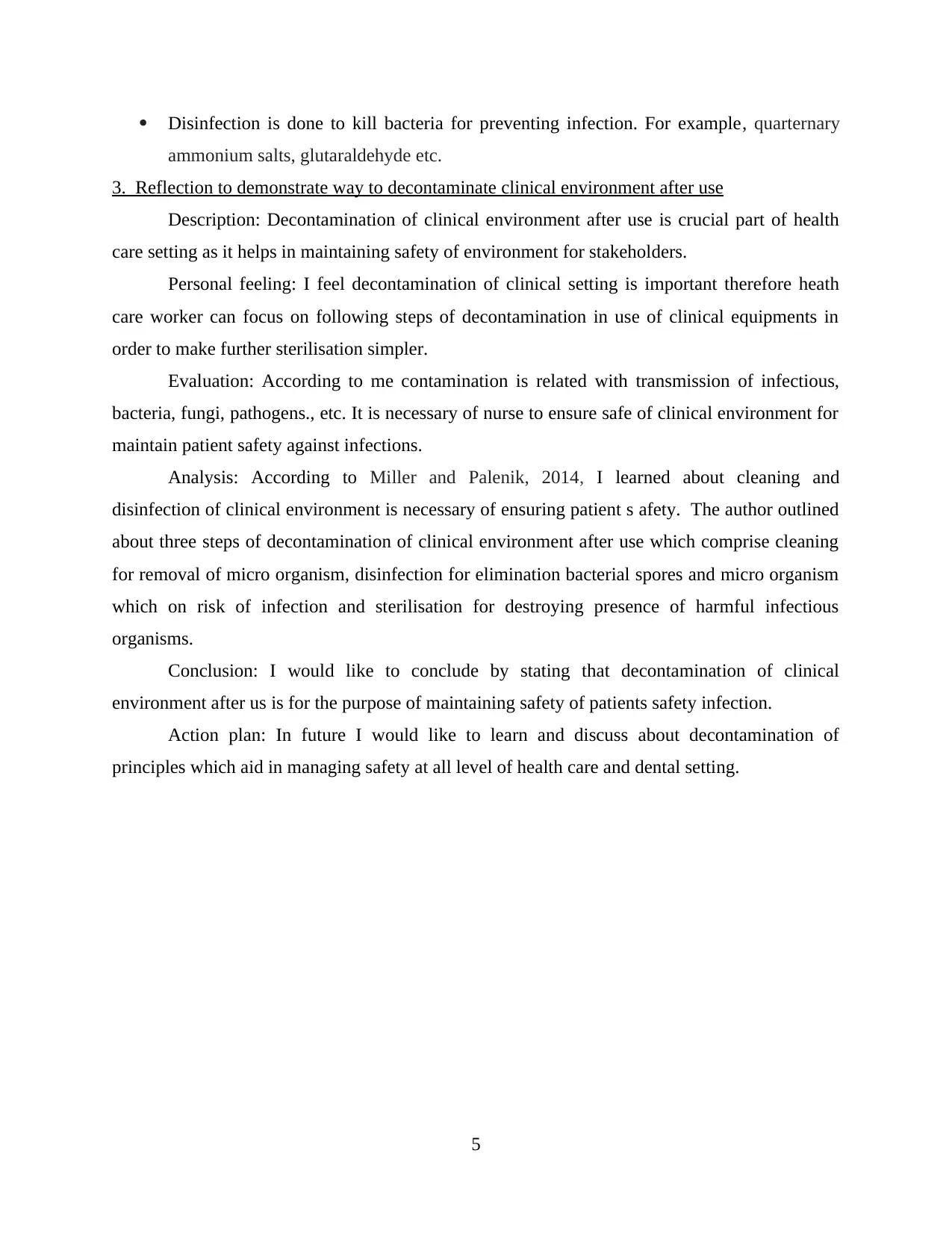
Disinfection is done to kill bacteria for preventing infection. For example, quarternary
ammonium salts, glutaraldehyde etc.
3. Reflection to demonstrate way to decontaminate clinical environment after use
Description: Decontamination of clinical environment after use is crucial part of health
care setting as it helps in maintaining safety of environment for stakeholders.
Personal feeling: I feel decontamination of clinical setting is important therefore heath
care worker can focus on following steps of decontamination in use of clinical equipments in
order to make further sterilisation simpler.
Evaluation: According to me contamination is related with transmission of infectious,
bacteria, fungi, pathogens., etc. It is necessary of nurse to ensure safe of clinical environment for
maintain patient safety against infections.
Analysis: According to Miller and Palenik, 2014, I learned about cleaning and
disinfection of clinical environment is necessary of ensuring patient s afety. The author outlined
about three steps of decontamination of clinical environment after use which comprise cleaning
for removal of micro organism, disinfection for elimination bacterial spores and micro organism
which on risk of infection and sterilisation for destroying presence of harmful infectious
organisms.
Conclusion: I would like to conclude by stating that decontamination of clinical
environment after us is for the purpose of maintaining safety of patients safety infection.
Action plan: In future I would like to learn and discuss about decontamination of
principles which aid in managing safety at all level of health care and dental setting.
5
ammonium salts, glutaraldehyde etc.
3. Reflection to demonstrate way to decontaminate clinical environment after use
Description: Decontamination of clinical environment after use is crucial part of health
care setting as it helps in maintaining safety of environment for stakeholders.
Personal feeling: I feel decontamination of clinical setting is important therefore heath
care worker can focus on following steps of decontamination in use of clinical equipments in
order to make further sterilisation simpler.
Evaluation: According to me contamination is related with transmission of infectious,
bacteria, fungi, pathogens., etc. It is necessary of nurse to ensure safe of clinical environment for
maintain patient safety against infections.
Analysis: According to Miller and Palenik, 2014, I learned about cleaning and
disinfection of clinical environment is necessary of ensuring patient s afety. The author outlined
about three steps of decontamination of clinical environment after use which comprise cleaning
for removal of micro organism, disinfection for elimination bacterial spores and micro organism
which on risk of infection and sterilisation for destroying presence of harmful infectious
organisms.
Conclusion: I would like to conclude by stating that decontamination of clinical
environment after us is for the purpose of maintaining safety of patients safety infection.
Action plan: In future I would like to learn and discuss about decontamination of
principles which aid in managing safety at all level of health care and dental setting.
5
Paraphrase This Document
Need a fresh take? Get an instant paraphrase of this document with our AI Paraphraser
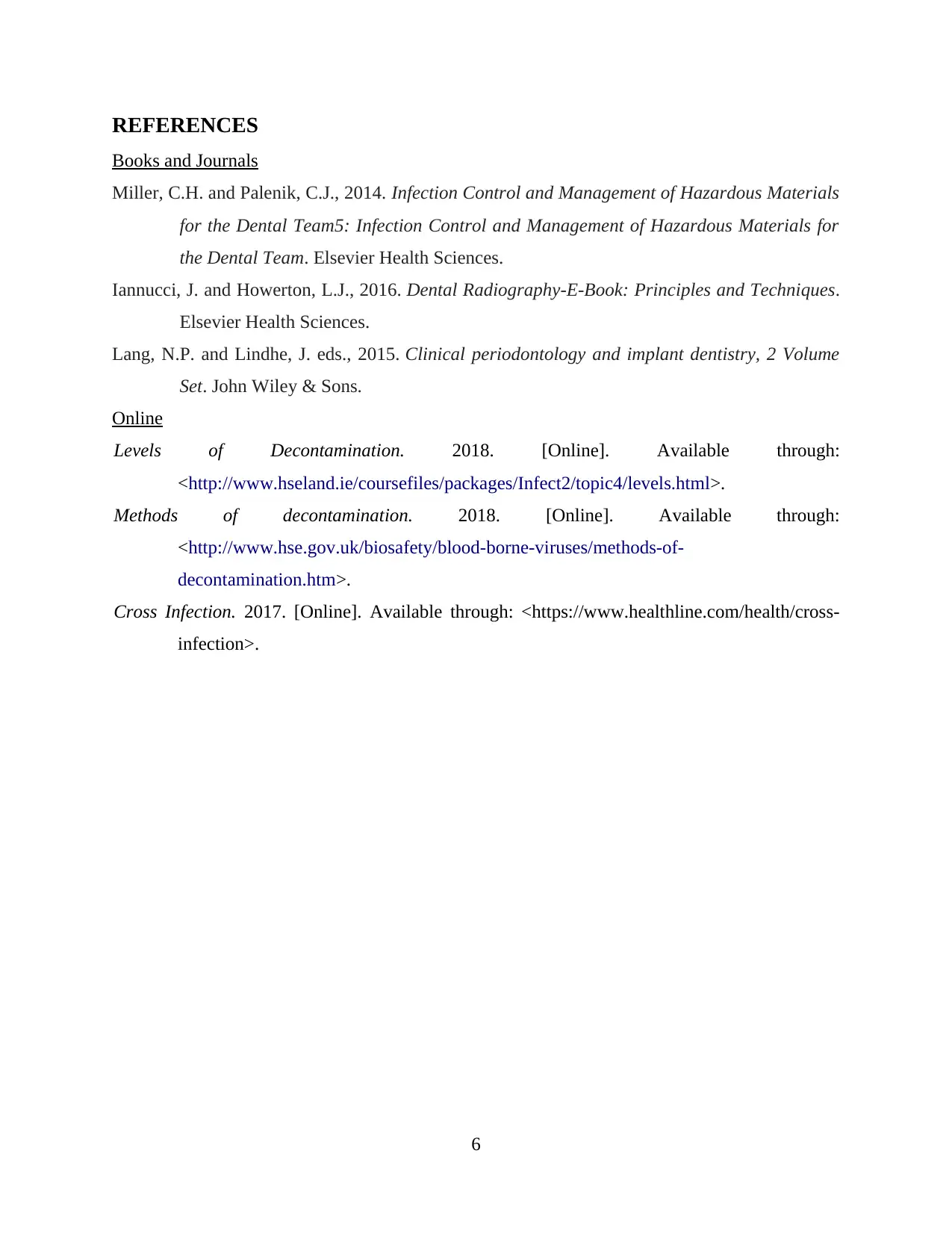
REFERENCES
Books and Journals
Miller, C.H. and Palenik, C.J., 2014. Infection Control and Management of Hazardous Materials
for the Dental Team5: Infection Control and Management of Hazardous Materials for
the Dental Team. Elsevier Health Sciences.
Iannucci, J. and Howerton, L.J., 2016. Dental Radiography-E-Book: Principles and Techniques.
Elsevier Health Sciences.
Lang, N.P. and Lindhe, J. eds., 2015. Clinical periodontology and implant dentistry, 2 Volume
Set. John Wiley & Sons.
Online
Levels of Decontamination. 2018. [Online]. Available through:
<http://www.hseland.ie/coursefiles/packages/Infect2/topic4/levels.html>.
Methods of decontamination. 2018. [Online]. Available through:
<http://www.hse.gov.uk/biosafety/blood-borne-viruses/methods-of-
decontamination.htm>.
Cross Infection. 2017. [Online]. Available through: <https://www.healthline.com/health/cross-
infection>.
6
Books and Journals
Miller, C.H. and Palenik, C.J., 2014. Infection Control and Management of Hazardous Materials
for the Dental Team5: Infection Control and Management of Hazardous Materials for
the Dental Team. Elsevier Health Sciences.
Iannucci, J. and Howerton, L.J., 2016. Dental Radiography-E-Book: Principles and Techniques.
Elsevier Health Sciences.
Lang, N.P. and Lindhe, J. eds., 2015. Clinical periodontology and implant dentistry, 2 Volume
Set. John Wiley & Sons.
Online
Levels of Decontamination. 2018. [Online]. Available through:
<http://www.hseland.ie/coursefiles/packages/Infect2/topic4/levels.html>.
Methods of decontamination. 2018. [Online]. Available through:
<http://www.hse.gov.uk/biosafety/blood-borne-viruses/methods-of-
decontamination.htm>.
Cross Infection. 2017. [Online]. Available through: <https://www.healthline.com/health/cross-
infection>.
6

7
⊘ This is a preview!⊘
Do you want full access?
Subscribe today to unlock all pages.

Trusted by 1+ million students worldwide
1 out of 9
Related Documents
Your All-in-One AI-Powered Toolkit for Academic Success.
+13062052269
info@desklib.com
Available 24*7 on WhatsApp / Email
![[object Object]](/_next/static/media/star-bottom.7253800d.svg)
Unlock your academic potential
Copyright © 2020–2025 A2Z Services. All Rights Reserved. Developed and managed by ZUCOL.





